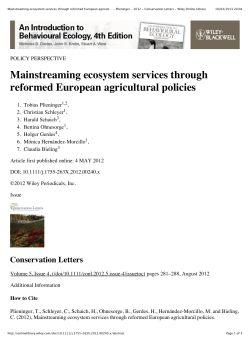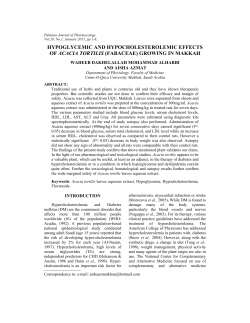
Spatial Demography of Giraffe in the Tarangire Tarangire--Manyara Manyara Ecosystem of Tanzania
Spatial Demography of Giraffe in the Tarangire--Manyara Ecosystem of Tanzania Tarangire WildNatureInstitute.org Our demographic study of Masai giraffe in the Tarangire-Manyara Ecosystem uses cutting-edge science to manage and conserve a currently declining ungulate species. The iconic giraffe is the national animal of Tanzania and a highly visible indicator of the health of savanna ecosystems. No one has yet studied demography of the giraffe population in this region. WildNatureInstitute.org The giraffe’s great height (>5-meters) allows it to forage in the tree canopy and so avoid food competition with other browsers such as kudus and impalas. They have tongues nearly 50 cm long and tough mouths so they can tolerate the thorns. They have evolved to exploit the niche of foraging high in the canopy where smaller antelopes cannot reach. WildNatureInstitute.org The evolutionary arms race between the giraffe and their favorite food – the acacia tree – led to the physical features both express today. Giraffe grew tall to eat nutritious leaves high up in the trees. The acacia grew thorns and produced tannins, but the giraffe also evolved a tough mouth and long tongue to strip leaves from the sharp thorny branches. Giraffe try to avoid eating tannins – but the tree will begin to produce these toxic compounds within minutes of a giraffe foraging on its leaves! The flat-topped shape of the acacia tree is also a response to giraffe foraging, so most of the leaves can be out of reach of the herbivore. Giraffe have evolved interesting adaptations to deal with the physical difficulties of being the world’s tallest animal. Their blood pressure is almost twice that of an average cow to enable blood to reach the brain so high above the heart. When a giraffe lowers its head to drink, blood could be expected to rush down the long neck and burst into the brain – but special valves in the neck veins and an intricate network of arteries (called a ‘rete mirabile’ or ‘carotid rete’) regulate blood flow to prevent brain damage or black outs. Their veins have thick walls, and they have thick skin like socks around their lower legs to prevent edema. WildNatureInstitute.org WildNatureInstitute.org Millions of years ago, primitive giraffoids once lived in Europe and Asia as well as throughout the African continent, but the modern giraffe is confined to just a few populations in subSaharan Africa. In fact, the 8 races are currently being investigated as distinct species. The TarangireManyara Ecosystem is in the stronghold of the most numerous race, the Masai giraffe. Many people think giraffe are doing well, but the IUCN estimated that giraffe populations have declined by 30% in the past 10 years! WildNatureInstitute.org The goal of our giraffe research is to figure out which areas within the Tarangire-Manyara Ecosystem are the most important for giraffes, and work to ensure these areas are adequately protected and connected. WildNatureInstitute.org The causes of giraffe declines include habitat loss (conversion of savanna to farms, deforestation for fuelwood), illegal poaching for meat, and – for Masai giraffes – a newly emerging Giraffe Skin Disease, the effects of which are unknown. WildNatureInstitute.org We are conducting a demography study using photographic mark-recapture, with each giraffe’s individual spot patterns acting as a unique identifier for the animal. By taking digital photographs of each giraffe and maintaining a photo-database with a geographical location for each photo-sighting, we are monitoring survival and movements of over 1,500 giraffes! WILD--ID Pattern WILD Pattern--Recognition Software We utilize a state-of-the-art computer program that recognizes every giraffe’s unique fur pattern from our photographs so we can identify and track individuals throughout their lives. These individual-based photographic data allow us to document births, deaths, and movements, and estimate population trends with the ultimate goal of protecting and connecting areas that support the highest giraffe survival and reproduction. WildNatureInstitute.org Computer-aided photographic identification enables very large sample sizes and is non-invasive and inexpensive, making long-term monitoring of many animals quite cost effective. All you need is a car, a camera, and a computer! We are estimating age-specific survival, reproductive success, and movement probabilities in different parts of our study area (parks, hunting blocks, village lands) as responses to: WildNatureInstitute.org • Vegetation type and quality • Water • Lion predation • Human poaching • Land management • Density dependence • Disease • • Our Long-term Project Goals are to: Determine where, when, and why giraffe are doing well. Suggest effective conservation measures to protect and connect important places for giraffe – so this fascinating species can survive and thrive in a healthy savanna habitat. WildNatureInstitute.org
© Copyright 2025


















